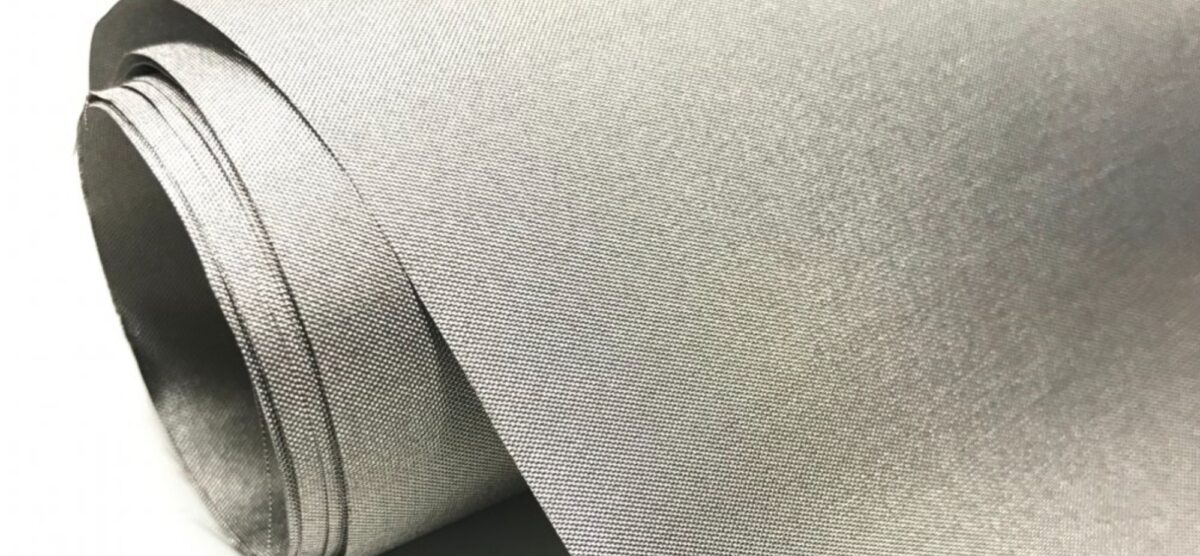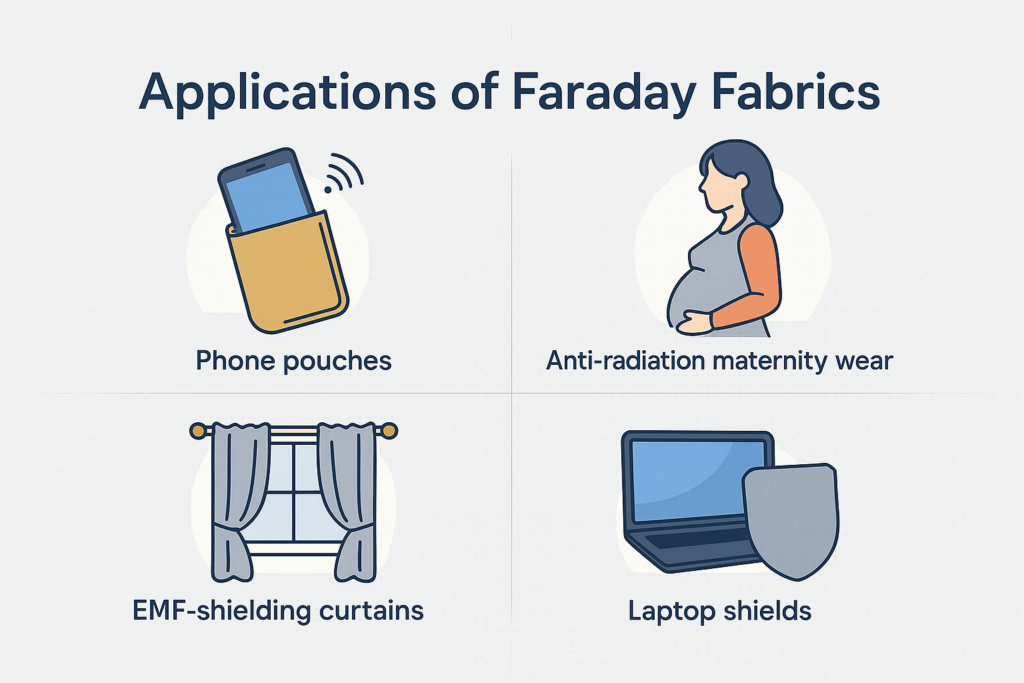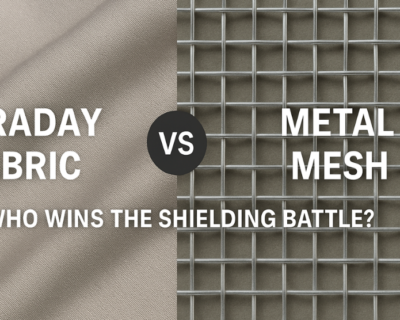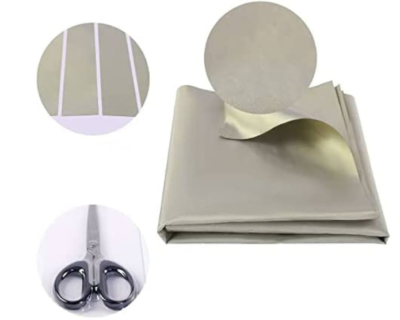Blogs

The Secret Shield in Your Pocket: How Faraday Fabrics Block EMF
Brought to you by DOMADIA™ — Smart Shielding for a Wireless World
Imagine you’re in a crowded airport, surrounded by a storm of invisible signals. Wi-Fi, Bluetooth, 5G, GPS—it’s all around you, bouncing off walls, connecting devices, transmitting data every second. Now picture a small fabric pouch in your backpack. The moment you drop your phone into it, everything goes quiet. No calls. No messages. No tracking. Your phone is still on, but it’s off the grid.
This is the power of Faraday fabrics, a revolutionary material designed to block electromagnetic fields (EMF) and radiofrequency (RF) radiation. As the digital world becomes more wireless, Faraday fabrics are becoming a quiet necessity—for personal privacy, health protection, and industrial security.
What Are Faraday Fabrics?
Faraday fabrics are smart textiles that incorporate metallic fibers into flexible cloth materials like cotton, polyester, or nylon. The science behind the fabric is rooted in the Faraday Cage, a concept discovered by Michael Faraday in the 1800s. Just like a Faraday Cage blocks EMF by redirecting electromagnetic energy around a shielded area, these fabrics use the same principle—woven into a breathable, wearable material.
What makes it effective is the fine network of metal threads embedded within the fabric. These threads are often made from highly conductive metals like silver, copper, nickel, or stainless steel, which absorb and deflect incoming electromagnetic radiation. The fabric doesn’t just block signals—it neutralizes them.
Chemical Composition & Structure
Faraday fabrics are typically made by weaving fine metallic fibers into a base textile. Here’s a quick snapshot of what’s inside:
- Base Material: Polyester, cotton, or nylon (for flexibility and strength)
- Conductive Metals:
- Silver (Ag)
- Copper (Cu)
- Nickel (Ni)
- Stainless Steel fibers
These materials are woven or plated onto the base fabric in microscopic threads. Silver and copper are most commonly used due to their high electrical conductivity and antimicrobial properties.
How Does Faraday Fabric Block EMF?
The concept is simple. When EMF or RF waves come into contact with the fabric, they hit the conductive mesh of metal fibers. These metals either reflect the waves or redirect the energy across the surface of the material, preventing it from passing through to the other side.
This technology can effectively shield against:
- Radio frequencies (RF): signals from phones, Wi-Fi routers, and Bluetooth devices
- Low frequencies (LF): emitted by power lines and electrical appliances
- Microwave radiation: such as signals from smart devices and microwave ovens
- Electric and magnetic fields: depending on the design and density of the material
Faraday fabrics act like an invisibility cloak for your devices and your body—shielding you from radiation without needing power or bulky equipment.
Technical Specifications
| Property | Value / Range |
| Shielding Effectiveness | 40–90 dB (depending on frequency) |
| Frequency Range | 10 kHz to 40 GHz |
| Surface Resistivity | < 0.1 ohms/sq |
| Tensile Strength | High (due to woven metal fibers) |
| Thickness | 0.1 mm – 0.5 mm |
| Air Permeability | Moderate to High |
| Washability | Some are machine-washable, others require hand-wash |
Where Are Faraday Fabrics Used?

Faraday fabrics are incredibly versatile and used in a variety of industries.
1. In personal protection, they’re used in phone pouches to block tracking, anti-radiation maternity wear to protect unborn babies, laptop shields for reproductive safety, and EMF-shielding curtains for homes and offices exposed to high radiation sources like Wi-Fi routers and smart meters.
2. In the medical field, Faraday fabrics help protect sensitive medical equipment from electromagnetic interference. They’re used in MRI rooms, in shielding garments for patients with pacemakers, and even in hospital uniforms and bed linens to reduce exposure in high-EMF environments.
3. In aerospace and military settings, the stakes are even higher. Faraday fabric is used for shielding aircraft cables, stealth technology, anti-surveillance tents, and protecting control rooms or classified data zones. These fabrics prevent external signals from breaching sensitive systems and communications.
4. In commercial and industrial applications, Faraday materials are used to protect data centers, server rooms, smart grid stations, and power equipment. They help ensure reliable performance of critical systems and reduce the risk of EMF-related malfunctions.
5. The digital privacy and cybersecurity world is also embracing this tech. Anti-skimming wallets and Faraday bags shield your credit cards, phones, and passports from RFID readers and hackers. Signal-blocking pouches are increasingly used by corporate executives, journalists, and travelers to prevent remote hacking or tracking.
6. Even DIY enthusiasts and environmentally conscious homeowners are using Faraday fabrics to create smart meter shields, radiation-reducing mats, or EMF-blocking laptop sleeves. It’s easy to cut, sew, and use in any creative or practical project.
Types of Faraday Fabrics and Their Uses
Let’s talk about the different kinds you might come across and where they fit best:
1. Heavily-Enforced Fabrics: These are basically used in military grade shielding, big RF shielding enclosures, and by law enforcement forensics investigators.
They’re thick and made to handle stuff like high altitude electromagnetic pulses, coronal mass ejections, and major electromagnetic interference. Ideal if you’re guarding sensitive data or protecting a whole building.
2. Lightly Reinforced Fabrics: These are perfect for anyone who wants EMF protection at home. Examples are curtains to block wireless signals from cell towers or smart meters. They’re flexible, easier to hang or wear, and still offer solid RF radiation shielding.
3. Blended Fabrics: These fabrics are comfy and practical, so you can wear them all day, every day. They’re good if you’re after digital privacy while looking cool. They’re also used by travelers who want to protect their identity and to avoid RF enclosures from tracking any of their devices.
Trusted by Industry Standards
To ensure their effectiveness, Faraday fabrics are tested under rigorous standards. Reliable fabrics meet:
- MIL-STD-285 – U.S. military standard for RF attenuation
- IEEE 299 – Shielding effectiveness test method
- EN 50147-1 – European method for RF testing
- RoHS & REACH – Certifications for environmental and human safety
These certifications confirm that the fabric will do what it promises—block electromagnetic radiation effectively and safely.
Available Formats
Faraday fabrics are available in many forms to suit different needs:
- Sheets & Rolls – For large-scale architectural or industrial projects
- Tapes – For sealing edges and gaps
- Fabric for Clothing – Soft, breathable materials for wearable shielding
- Faraday Pouches & Bags – Ready-to-use mobile protection
- EMF Mesh & Paint – For permanent installations in walls or enclosures
This wide range ensures you can find the right format for your use—whether you’re shielding a hospital room or making your own radiation-proof wallet.
Why It Matters for the Environment
Faraday fabrics offer more than just signal protection—they offer sustainable shielding. Unlike traditional shielding methods that require heavy metals or constant power, these fabrics are lightweight, reusable, and energy-free. They extend the life of electronics by reducing interference, which means less frequent replacements and less e-waste.
Using Faraday fabric also reduces the need for recycling and disposal of short-lived tech, which helps cut down on the environmental damage caused by mining, manufacturing, and electronic waste processing.
Final Word from DOMADIA™
At DOMADIA™, we are committed to building a safer, smarter future through advanced shielding materials. Whether you’re protecting your personal space, securing sensitive equipment, or designing a shielded facility, our Faraday fabric solutions combine science, flexibility, and functionality to meet the challenge. Because in a world full of signals, you deserve some silence.
👉 Contact Us Now | 🌐 Visit: www.domadia.net
Talk to us: Kairav Domadia | Aadil Domadia | Er.Pankaj Domadia | Pragati Sanap | Pooja N N | Shivani Kanojia




